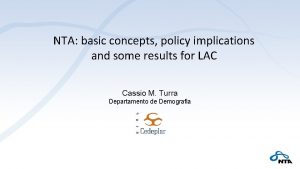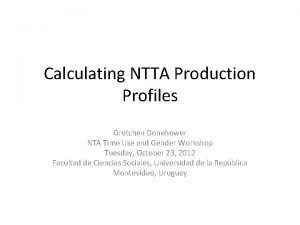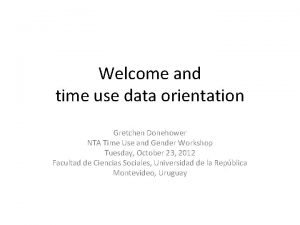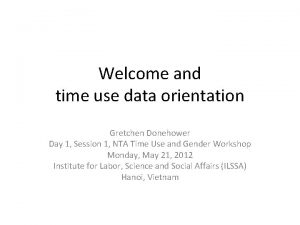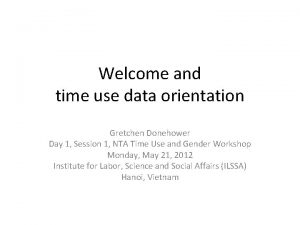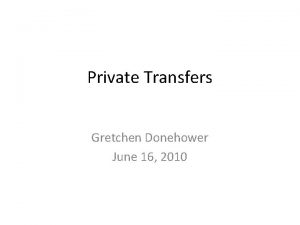Imputing Wages to Activities Gretchen Donehower NTA Time









- Slides: 9

Imputing Wages to Activities Gretchen Donehower NTA Time Use and Gender Workshop Tuesday, October 23, 2012 Facultad de Ciencias Sociales, Universidad de la República Montevideo, Uruguay

Outline 1. Wage Data Questionnaire 2. Methods for Imputing Wages 3. Why NTTA uses Specialist Replacement Method 4. Which wages to use for which activities? 5. Quality Adjustment 6. Taxes and Other Adjustments

Wage Data Questionnaire 1. What type of wage data is available for you to use? 2. What is the coding scheme for different jobs or occupations? 3. Is the data pre-tax or post-tax? 4. Do the wages include fringe benefits or employer-paid taxes?

Methods for Imputing Wages • Different methods for different types of research questions – Replacement method: what would you have to pay to buy the service in the market? • Can replace with generalist or specialist wages – Opportunity cost method: what could you earn with your time in the market if you worked for pay instead of doing the household activity? • NTTA uses specialist replacement

Why use specialist replacement? • NTA is mostly concerned with accounting type questions, not behavioral models or individual incentives • Opportunity cost analyses sometimes come up with values of household production that are so large that no one pays attention – Reveals the limitations of the behavioral model and measurement issues with opportunity cost method

Which Wages to Use? • Country teams must decide what is appropriate in their context • Can use single occupation or average of different occupations – Use employment-weighted averages to reflect the distribution of occupation types in the market • US, 2009 example:

Time Use Activity 1. Cleaning Standard Occupational Classifications Used for Wages (and Codes) Maids and housekeeping cleaners (37 -2012) and their supervisors (37 -1011) 2. Laundry and dry-cleaning workers (51 -6011), hand sewers (516051), tailor, dressmakers, and custom sewers (51 -6052) 3. Cooking Food preparation and serving related occupations (major category 35 -0000) 4. Household maintenance and Maintenance and repair workers, general (49 -9042), Helpers— repair installation, maintenance, and repair workers (49 -9098) 5. Lawn and garden care Landscaping and groundskeeping workers (37 -3011) and their supervisors (37 -1012), grounds maintenance workers (37 -3019) 6. Household management Management occupations (major category 11 -0000), business and financial occupations (major category 13 -000) and office and administrative support occupations (major category 43 -0000) 7. Pet care Nonfarm animal caretakers (39 -2012) 8. Purchasing goods and services Personal care and service occupations (major category 39 -0000) 9. Childcare Child care workers (39 -9011), preschool teachers, except special education (25 -2011), and child, family and school social workers (21 -1021) 10. Eldercare and care outside Community and social service occupations (major category 21 the home, and volunteering 0000) and personal and home care aides (39 -9021) 11. Travel Taxi drivers and chauffers (53 -3041) Avg Hourly Wage 11. 33 Quality Adjustment 0. 75 10. 43 0. 75 10. 04 0. 75 17. 08 0. 75 13. 15 0. 75 24. 59 1 10. 50 11. 87 13. 42 1 17. 85 1 11. 51 1

Quality Adjustment • Reflects difference in productivity between the market and household for some activities – Different availability of capital (physical and human) – Efficiencies in the market from specialization – Some activities need this adjustment, others do not • Would like to add an age-productivity adjustment, but have not figured out how

Taxes and Other Adjustments • Pre-tax or post-tax? • Adjustment for supplements to wages – In some countries, supplements to wages and salaries are a large part of total market labor income (mandatory employer taxes, fringe benefits) – We want our replacement method to reflect costs in the market, so need to increase wages to reflect this additional replacement expense – So, adjust imputed wage ratio of supplements to total wages and salaries from national accounts (i. e. multiply by 1+[supplements to wages and salaries / wages and salaries])


